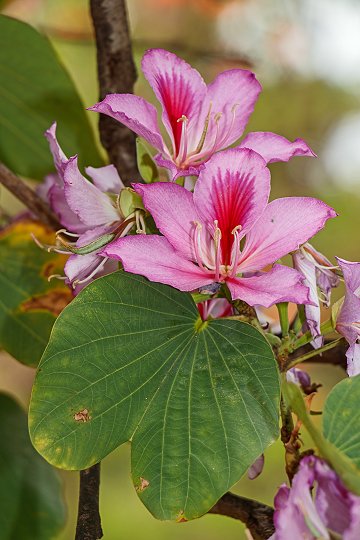
|
|
Ďrchid tree
( Bauhinia variegata). Flowers and leaves.
|
Ďrchid tree - Bauhinia variegata
Bauhinia variegata is a species of flowering plant in the legume family, Fabaceae. It is native to an area from China through Southeast Asia to the Indian
subcontinent. Common names include orchid tree (though not belonging to the family Orchidaceae) and mountain
ebony.
A multipurpose tree, it is gathered from the wild for food, medicine and many other commodities. The tree is extremely handsome in flower and is often grown as an ornamental, hedge plant or street tree in tropical areas. It is valued particularly for its showy fragrant, pink, purple or white flowers.
English botanist Francis Buchanan-Hamilton discovered Bauhinia variegata in 1822 while exploring China, but the orchid has held reverence throughout Chinese culture and stands as a symbol of nobility, beauty, and innocence which has held fast for thousands of years as various dynasties cultivated the orchids as part of their culture.
In China, it seems that this tree is considered to be sacred because the Buddhists plant it near to their pagodas.
It is a small to medium-sized, fast-growing, attractive, tree growing to 10–12 metres (33–39 ft) tall, deciduous in the dry
season, with a dense, spreading crown. The tree often has more than one main bole; the bole is short and often crooked.
Leaves alternate( 10–20 cm long), long petioled (to 3 cm [1.25 in] long), thin-leathery, simple but deeply cleft at apex, forming 2 large rounded lobes; lower surfaces downy, especially at top of petiole; blades with 11-13 veins extending from heart-shaped or rounded base.
Flowers showy, fragrant, in few-flowered clusters near stem tips, appearing during leaf fall (early spring); 5 petals, clawed, overlapping, pale magenta to indigo (occasionally white), with dark red and yellow also on upper petal; 5 stamens (rarely
6).
Fruit a flat, oblong seedpod 15–30 centimetres (5.9–11.8 in) long, containing several
seeds (10-15). The seedpod dries completely on the tree, and when mature begins to twist into a helix or corkscrew shape, ultimately exploding open—with a very audible "clack"—to deliver its seeds into the environs.
Young leaves, flower sand flower buds and fruits are
edible, boiled and eaten as a vegetable, or pickled.
Kachnar is a local name in the Indian subcontinent for the edible buds collected from the tree; it is widely used as an ingredient in many subcontinent recipes. Traditional kachnar curry is prepared using kachnar buds, yogurt, onions and native spices. Kachnar buds are also eaten as a stir-fried vegetable and used to make achaar, a pickle in many parts of the Indian sub-continent. It shows a good antioxidant and anticancer activity.
In Nepal, the plant is known as koiralo and the flower is known as koiralo ko phool in Nepali language. The flower and the buds are used to make Nepalese style achaar. The flowers and buds are boiled for a while and then mixed with roughly mashed boiled potato, chopped green chilies, chopped onions, fresh peas, coriander leaves and spices like timmur, salt, pepper, turmeric powder, roasted sesame powder (til ko chhop), cumin powder and coriander powder. Heated mustard oil and fenugreek seeds is then added to the mixture and then lemon juice or lime juice concentrate (chuk amilo in Nepali) is then added as per taste. The achar is then served instantly. The achar is important part of the meal served during the Ghode Jatra festival.
Medicinal uses. The bark is alterative, anthelmintic, astringent and tonic. The juice of the bark is used in the treatment of amoebic dysentery, diarrhoea and other stomach disorders. A paste of the bark is useful in the treatment of cuts and wounds, skin diseases (including leprosy), scrofula and ulcers.
The dried buds are used in the treatment of piles, dysentery, diarrhoea and worms.
The juice of the flowers is used to treat diarrhoea, dysentery and other stomach disorders.
The root is used as an antidote to snake poison. A decoction of the root is used to treat dyspepsia.
Other Uses. The plant is sometimes grown as an ornamental hedge.
The bark is a source of tannins. It is used for dyeing in various shades of brown.
The young green bark detaches easily from the tree and yields a fibre that is used for cordage.
The tree yields a gum. The wood is brown, moderately hard and heavy with an attractive grain. It is used for house construction and making household and agricultural implements.
One of the main uses of the tree is as fuel. The calorific value is 4 800 kcal/kg.
Source:
https://en.wikipedia.org/wiki/Bauhinia_variegata
https://tropical.theferns.info/viewtropical.php?id=Bauhinia+variegata
https://plantatlas.usf.edu/flip/plant.aspx?id=49
https://apps.cals.arizona.edu/arboretum/taxon.aspx?id=367n
